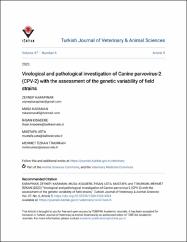| dc.contributor.author | Karapınar, Zeynep | |
| dc.contributor.author | Karaman, Musa | |
| dc.contributor.author | Kısadere, İhsan | |
| dc.contributor.author | Usta, Mustafa | |
| dc.contributor.author | Timurkan, M. Özkan | |
| dc.date.accessioned | 2024-02-05T15:58:13Z | |
| dc.date.available | 2024-02-05T15:58:13Z | |
| dc.date.issued | 2023 | |
| dc.identifier.issn | 1300-0128 | |
| dc.identifier.issn | 1303-6181 | |
| dc.identifier.uri | https://doi.org/10.55730/1300-0128.4324 | |
| dc.identifier.uri | https://search.trdizin.gov.tr/yayin/detay/1221084 | |
| dc.identifier.uri | https://hdl.handle.net/20.500.12462/13861 | |
| dc.description.abstract | Canine parvovirus-2 (CPV-2), which is common worldwide, is a highly contagious pathogen in domestic dogs and some wild carnivore species. The agent causes a multisystemic infection in affected animals, especially acute hemorrhagic enteritis and fatal myocarditis in puppies. The study aimed to reveal the presence of virus in dogs with clinical symptoms of CPV-2 infection using virological, pathological, and immunohistochemical methods and make molecular characterization based on partial VP-2 gene of strains circulating in the region. As a result of PCR studies, 9 out of 16 rectal swab samples and 17 out of 38 blood samples were positive. A phylogenetic map was created by analyzing the partial VP2 gene sequences obtained from GenBank and the sequences obtained from this study. It was determined that 6 of the leukocyte samples obtained from the study were in CPV-2a, 5 of the leukocyte and 4 swab samples were in CPV-2b types. Amino acid differences were determined between the obtained sequences and the strains provided in GenBank. In the histopathological examination, lesions of varying degrees were found in all intestinal sections, while the most prominent lesions were seen in the ileocecal valve. Segmental or dense serosal hemorrhages were observed extending to the muscle layer and submucosa in the intestine. In the immunohistochemical examination, the most intense immune reaction was defined in the crypts. In order to control the infection, it is recommended to determine the circulating variants by conducting molecular epidemiological studies in different geographical regions, to support the research with different methods, and to develop the vaccines to be used according to the diversity of genetic variants. | en_US |
| dc.language.iso | eng | en_US |
| dc.relation.ispartof | Turkish Journal of Veterinary and Animal Sciences | en_US |
| dc.rights | info:eu-repo/semantics/openAccess | en_US |
| dc.rights | Attribution 4.0 International | en_US |
| dc.rights.uri | https://creativecommons.org/licenses/by/4.0/ | en_US |
| dc.subject | Canine Parvovirus-2 | en_US |
| dc.subject | Molecular Characterization | en_US |
| dc.subject | Immunohistochemistry | en_US |
| dc.subject | Histopathology | en_US |
| dc.subject | Phylogenetic Analysis | en_US |
| dc.title | Virological and pathological investigation of Canine parvovirus-2 (CPV-2) with the assessment of the genetic variability of field strains | en_US |
| dc.type | article | en_US |
| dc.contributor.department | Balıkesir Üniversitesi | en_US |
| dc.identifier.volume | 47 | en_US |
| dc.identifier.issue | 6 | en_US |
| dc.identifier.startpage | 544 | en_US |
| dc.identifier.endpage | 555 | en_US |
| dc.relation.publicationcategory | Makale - Ulusal Hakemli Dergi - Kurum Öğretim Elemanı | en_US |
| dc.buozel | trdizinideal | en_US] |
| dc.department-temp | Balıkesir Üniversitesi, Veteriner Fakültesi, Viroloji Anabilim Dalı, Balıkesir, Türkiye Balıkesir Üniversitesi, Veteriner Fakültesi, Patoloji Anabilim Dalı, Balıkesir, Türkiye Balıkesir Üniversitesi, Veteriner Fakültesi, Fizyoloji Anabilim Dalı, Balıkesir, Türkiye Balıkesir Üniversitesi, Veteriner Fakültesi, Patoloji Anabilim Dalı, Balıkesir, Türkiye Atatürk Üniversitesi, Veteriner Fakültesi, Viroloji Anabilim Dalı, Erzurum, Türkiye | en_US |
| dc.identifier.trdizinid | 1221084 | en_US |
| dc.identifier.doi | 10.55730/1300-0128.4324 | |



















